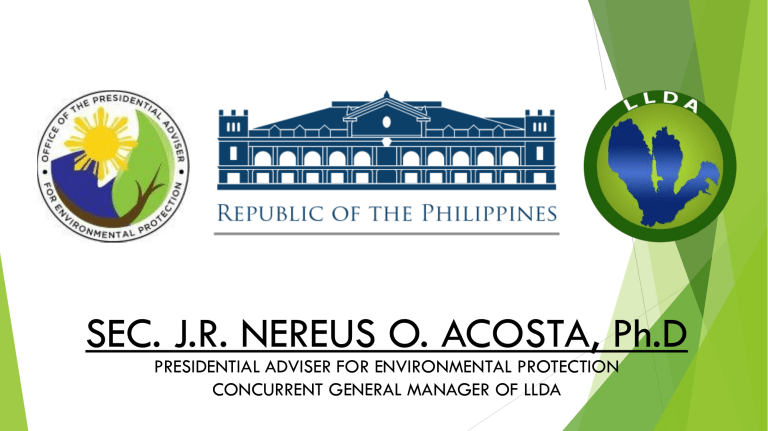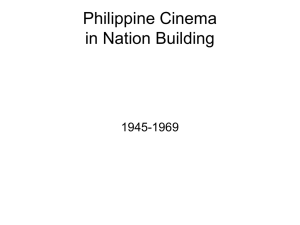
SEC. J.R. NEREUS O. ACOSTA, Ph.D PRESIDENTIAL ADVISER FOR ENVIRONMENTAL PROTECTION CONCURRENT GENERAL MANAGER OF LLDA Presentation of Philippine Clean Water Act of 2004 as Principal Author SEC. J.R. NEREUS O. ACOSTA, Ph.D PRESIDENTIAL ADVISER FOR ENVIRONMENTAL PROTECTION CONCURRENT GENERAL MANAGER OF LLDA 65,000 hectares Metro Manila 95,000 hectares Laguna Lake CORY AQUINO NOYNOY AQUINO Why the need for the Clean Water Act? Low sewerage coverage Degradation of water quality from domestic wastes Spread of waterborne diseases Decline in fish production Low Sewerage Coverage in 2004 Vientiane Jakarta Manila Ho Chi Minh City Kathmandu Dhaka Colombo Phnom Penh Ulaanbaatar Karachi Delhi Shanghai Kuala Lumpur Tashkent Chengdu Seoul Osaka Hong Kong 4% 0 20 40 60 80 Only about 4% of the population had access to sewerage in 2000 Outside Metro Manila, access to sewerage network almost non-existent 100 Source: Asian Development Bank. 2004. Water in Asian Cities: Utilities Performance and Society Views. Manila. Indiscriminate disposal of wastewater is one of the main reasons for degradation of water quality Domestic Wastes 80% of biochemical oxygen demand (BOD) loading in the lake is from domestic sources - Phil-WAVES report, 2015 *Manggahan Floodway, Pasig River Spread of Waterborne Diseases in 2000s In 1996-2000, 31% of illnesses were from waterborne diseases; gastroenteritis, diarrhea, typhoid, cholera, dysentery, and hepatitis Decline in Fish Production Fish kills as a result of increase in BOD levels, sedimentation and silt pollution 70% of bangus sold in Metro Manila is from Laguna Lake Philippine Clean Water Act R.A. 9275 “An Act Providing for a Comprehensive Water Quality Management and for Other Purposes” March 2004 *Laguna de Bay Philippine Clean Water Act R.A. 9275 The State shall pursue a policy of economic growth in a manner Consistent with the protection, preservation and revival of the quality Of our fresh, brackish and marine waters. -Declaration of Policy, Section 2 of Philippine Clean Water Act *Angat Dam, Norzagaray, Bulacan Philippine Clean Water Act R.A. 9275 This Act shall apply to water quality management in all water bodies, That it shall primarily apply to the abatement and control of pollution From land based sources, that the water quality standards and Regulations under this Act shall be enforced irrespective of sources Of pollution -Coverage of the Act, Section 3 of Philippine Clean Water Act *La Mesa Dam Key Definitions Effluent - discharge which is passed into bodies of water Wastewater - wastes in liquid form containing pollutants Key Definitions Septage : sludge from septic tanks, cesspools (pozo negro) Key Definitions Sewage : wastewater from domestic, commercial, industrial sources Sewerage : system or network of pipelines for collection and treatment of sewage Sewage Collection, Treatment & Disposal Section 8 requires residential, commercial and industrial establishments to connect to a sewage line provided by concessionaires Discharge Permits Section 14 regulates effluent discharge to bodies of water LLDA as regulatory agency monitoring discharges to Laguna Lake Prohibited Acts Section 27 prohibits the ff: Discharging directly or indirectly into water bodies causing water pollution Discharging without valid discharge permits Dumping or transporting into water bodies sewage sludge or solid waste Disposing of infectious medical wastes Penalties & Enforcement Fine of not less then Php 10,000 to Php 200,000 per day of violation Issuance of an ex parte order for closure, suspension or cessation of operations of violators Oil Spill in Pandacan, Manila June 2013 Around 1,500 liters of fuel from an oil depot spilled and polluted Pasig River Oil Spill in Pandacan, Manila June 2013 “The parameters for the Clean Water Act have been violated by Larraine’s Marketing.” Sec. Neric Acosta on the oil spill, June 2013 Cement plant oil spill, Antipolo September 2015 2,000 liters of bunker fuel spilled into Tagbak River, Antipolo. Cement plant oil spill, Antipolo September 2013 “Anything that compromises water safety, such as sources of hazardous and toxic substances like oil depots, should be removed from our rivers and major bodies of water,” - Sec. Acosta, Presidential Adviser for Environmental Protection Sept. 15, 2015, issuance of Ex-Parte Order to stop operations of Solid Cement International Coastal Cleanup September 19, 2015 International Coastal Cleanup in Las Pinas L.A.H.A.T. LUPA TUBIG TAO AT HANGIN ARAW L.A.W.S. LAND AIR WATER AND SUN Understand Value Protect Ecosystems. Life.


